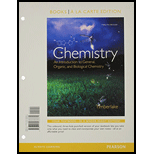
To Determine: The correct diagram that matches the given statements
Answer to Problem 9.71UTC
Solution:
a) Diagram 1
b) Diagram 2
c) Diagram 1
Explanation of Solution
“Like dissolves like”. In other words, a polar solute will dissolve in a polar solvent. And, a non-polar solute will dissolve in a non-polar solvent.
- Given: a polar solute and a polar solvent
- Given: a non-polar solute and a polar solvent
- Given: a non-polar solute and a non-polar solvent
Diagram 1 depicts this scenario. Here both solute and solvent have the same nature i.e. they are polar. In diagram 1, the pink and blue balls are uniformly dispersed indicating that they mix with each other or can be dissolved.
Diagram 2 depicts this scenario. Here the solute is non-polar while the solvent is polar. Since the two are different, they will not mix and tend to separate out into two layers like the orange and blue balls shown in diagram 2.
Diagram 1 depicts this scenario. Here both solute and solvent have the same nature i.e. they are non-polar. Again as shown in diagram 1, the pink and blue balls are uniformly dispersed indicating that they mix with each other or can be dissolved.
Diagram 1 depicts a solution containing a polar solute and polar solvent
Diagram 2 depicts a solution containing a non-polar solute and polar solvent
Diagram 1 depicts a solution containing a non-polar solute and non-polar solvent

Want to see more full solutions like this?
Chapter 9 Solutions
Chemistry: An Introduction to General, Organic, and Biological Chemistry, Books a la Carte Edition & Modified MasteringChemistry with Pearson eText -- ValuePack Access Card Package
 ChemistryChemistryISBN:9781305957404Author:Steven S. Zumdahl, Susan A. Zumdahl, Donald J. DeCostePublisher:Cengage Learning
ChemistryChemistryISBN:9781305957404Author:Steven S. Zumdahl, Susan A. Zumdahl, Donald J. DeCostePublisher:Cengage Learning ChemistryChemistryISBN:9781259911156Author:Raymond Chang Dr., Jason Overby ProfessorPublisher:McGraw-Hill Education
ChemistryChemistryISBN:9781259911156Author:Raymond Chang Dr., Jason Overby ProfessorPublisher:McGraw-Hill Education Principles of Instrumental AnalysisChemistryISBN:9781305577213Author:Douglas A. Skoog, F. James Holler, Stanley R. CrouchPublisher:Cengage Learning
Principles of Instrumental AnalysisChemistryISBN:9781305577213Author:Douglas A. Skoog, F. James Holler, Stanley R. CrouchPublisher:Cengage Learning Organic ChemistryChemistryISBN:9780078021558Author:Janice Gorzynski Smith Dr.Publisher:McGraw-Hill Education
Organic ChemistryChemistryISBN:9780078021558Author:Janice Gorzynski Smith Dr.Publisher:McGraw-Hill Education Chemistry: Principles and ReactionsChemistryISBN:9781305079373Author:William L. Masterton, Cecile N. HurleyPublisher:Cengage Learning
Chemistry: Principles and ReactionsChemistryISBN:9781305079373Author:William L. Masterton, Cecile N. HurleyPublisher:Cengage Learning Elementary Principles of Chemical Processes, Bind...ChemistryISBN:9781118431221Author:Richard M. Felder, Ronald W. Rousseau, Lisa G. BullardPublisher:WILEY
Elementary Principles of Chemical Processes, Bind...ChemistryISBN:9781118431221Author:Richard M. Felder, Ronald W. Rousseau, Lisa G. BullardPublisher:WILEY





